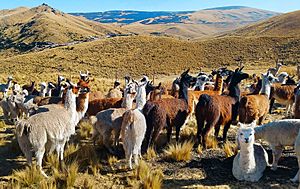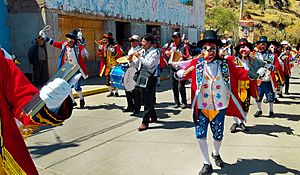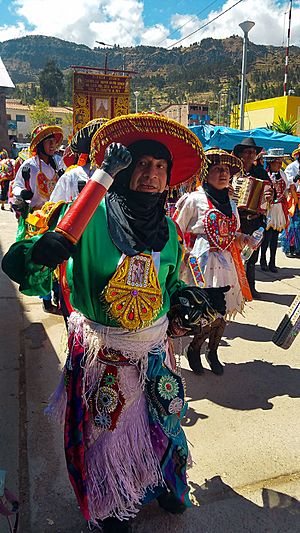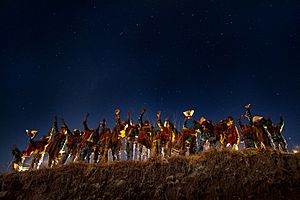Chinchaypujio District facts for kids
Quick facts for kids
Chinchaypujio
Chinchay Pukyu
|
||
|---|---|---|
|
District
|
||
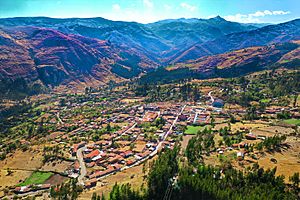 |
||
|
||
| Country | ||
| Region | ||
| Province | ||
| Founded | October 1, 1941 | |
| Capital | Chinchay Pukyu | |
| Area | ||
| • Total | 390.58 km2 (150.80 sq mi) | |
| Elevation | 3,105 m (10,187 ft) | |
| Population
(2005 census)
|
||
| • Total | 5,521 | |
| • Density | 14.1354/km2 (36.610/sq mi) | |
| Time zone | UTC-5 (PET) | |
| UBIGEO | 080304 | |
| Website | https://www.facebook.com/Municipalidad-Distrital-de-Chinchaypujio-367758549965836/ | |
Chinchaypujio is a district in Peru, located about two hours away from the city of Cusco. Its name comes from the Quechua language and means "Oncilla Spring." People sometimes call it "Chincha" for short.
The main town, also called Chinchaypujio, has a weekly market. This market is called Mercado Ferial de Chinchaypujio. The district is made up of nine communities: Chinchaypujio, Ocra, Paucarccoto, Parcotica, Waccahualla, Huancancalla, Sumaru, Pantipata, and Huamumayo. The Apurímac River flows through the southern part of the district. A main road for trade also crosses the district, connecting the Cusco Region with the Apurímac Region.
Contents
Exploring Chinchaypujio's Geography
The district of Chinchaypujio has a big difference in height from south to north. This means it has many different climate zones. In the south, the Apurímac River is at about 2,200 meters (7,200 feet) above sea level. Here, tropical fruits like bananas can grow. In the north, the Wintanayuq peak is around 4,200 meters (13,800 feet) high, which is above the Tree line.
Mountains of Chinchaypujio
Here are some of the mountains found in the district:
- Aqu Qalla
- Iskay Patayuq
- Kunka Waylla
- Kuntur Marka
- Kuyuq
- Mawk'a Llaqta
- Puma Pata
- Qucha Pampa
- Quyllu Wank'a
- Quyllur Q'asa
- Q'usñi Pata
- Saqsa Urqu
- Sayaq Rumi
- Silla Pallqa
- Warankuyuq
- Wikuntuniyuq
- Willka Pampa
- Yana
- Yura Qaqa
Farming and Animals in Chinchaypujio
Life in Chinchaypujio is very much shaped by farming and herding animals. Most families here work in agriculture, which is a big part of the local economy.
Animals Raised in the Highlands
In the higher parts of Chinchaypujio, people herd animals like Llamas and Alpacas, which are native to the Andes mountains. They also raise Sheep, Cattle, Chicken, and Horses. Shepherds often walk for more than an hour to take their animals to grazing grounds and bring them back. A special animal raised here is the Guinea pig, which has been bred for food for hundreds of years.
Crops Grown in the Region
Farmers grow many crops in the sloped and flat fields of the highlands. They mostly grow Tuber plants, especially about 40 types of Potatoes. Some common types include Olluco, Maswa, and Añu. Other important crops are Quinoa, Wheat, Beans, Tarwi, Maize (corn), and Barley.
Because the land is very hilly, it's hard to use big farm machines. So, farmers often plow their fields by hand or with horses. Flour from these crops is used to make a traditional sweet breakfast drink, similar to Oatmeal. A popular local drink is Chicha, which is a sweet corn beer.
In the warmer lowlands near the Apurimac River, farmers grow tropical fruits. These include Bananas, Papayas, and Avocados.
Chinchaypujio's Rich Culture
Chinchaypujio has many festivals throughout the year. These events often include parades and dances with colorful costumes. Each costume and character has a special history, sometimes telling a story about past events. Different Dance troupes organize themselves, each performing a specific dance with unique costumes. A leader called a Caporal guides each group.
The communities in Chinchaypujio work hard to protect their Quechua culture, nature, and farming traditions. For example, the community of Ocra is focused on keeping old knowledge alive. In 2014, a project from Chinchaypujio won an award from CRESPIAL. This award was for "Protecting [its] Intangible Cultural Heritage," showing how important their culture is.
Traditional Costumes and Dances
- Cchuchu: This is a very important dance that started in Chinchaypujio. It's said to have been inspired by a dream. Dancers wear white, carry willow branches, and tremble during the dance.
- Huayllascha: An ancient dance from the Inca Empire times. Single men and women dance together, hoping to find partners. Women wear braided hair, round hats, and black dresses with bright colors.
- Q'Apaq Negro: This dance from the colonial era remembers the time of slavery for Afro-Peruvians. Men wear round hats, scarves, blue pants, black masks, and carry small scepters. The dance shows the struggles of slavery but also the strength of black people gaining freedom.
- Saqras Chinchaypujio: These dancers represent the court of Lucifer (the Devil). They enter festivities at night with torches, as if coming from hell. When the Virgin Mary statue is brought out, the Saqras cover their faces, showing Mary's power over evil. They wear long wigs with Deer horns and colorful, striped outfits.
- Negrillas: Women perform this slow dance, showing their devotion to the Virgin Mary for their freedom from slavery. They wear white dresses, circular hats, and black scarves, but no masks.
- Q'Apaq Qolla: This dance celebrates the historical trade between the Collao/Puno region and the Anta Province, including Chinchaypujio. This trade brought wealth to both areas. Dancers wear white masks, green-yellow scarves, and large red plates on their backs.
- Mollos Tinkus: This dance is performed only from May to July. It's part of the Harvest festival for potatoes in Chinchaypujio. Female dancers wear wide skirts that move a lot, decorated with colorful stitched patterns.
- Wayna Q'Oyacha: Single women ("Qoyachas") and men ("Huaynas") perform this dance to show they are ready for marriage. Women wear white and pink dresses. Men wear colorful Inca-style hats, masks, and red vests. This dance is popular across the Cusco Region.
- Contra Danza: This dance started in Colonial Peru. It makes fun of the rich colonial people who would not let Indigenous and Mestizo people into their parties. Farmers created these "Against Dances" to protest. The lead dancer dresses like a landlord, and others wear red scarves and colorful pants.
- Coca Saruy: This dance tells the story of enslaved farmers forced to move from the Andes mountains to the Peruvian Jungle to work on coca farms. Their torn pants show the hard journey back to the highlands. The dance is light-hearted because many workers escaped and were happy to be alive. At the end, performers fall to the ground, shaking, to remember those who died from diseases like Malaria. A children's group, "Terrala Cocasaru," is part of this tradition. They end the dance by asking adult women to dance, showing the joy farmers felt when reuniting with their communities. Dancers wear white felt hats, plaid shirts, and torn denim pants.
- Majeños Chinchaypujio: These dancers wear masks, wide white hats, and brown leather jackets.
- Siqllas Chinchaypujio: This dance represents dishonest Lawyers, Judges, and government officials who treated farmers unfairly. Dancers wear masks, black hats, and red or blue suits. They hit a black book with a small whip, symbolizing how powerful writings like the Penal code or Bible were used to punish the poor. Some groups also include a construction manager or politician, hitting stacks of money. The dance is funny and satirical.
- Auqa Chileno: This dance was created by Peruvian soldiers who fought in the War of the Pacific. It makes fun of their Chilean opponents. Dancers wear pointy hats and masks with big noses.
- Runa Toro: This dance happens in a Bullring. Two people pretend to be in a bullfight, wearing fluffy costumes and using a patterned blanket like those in real bullfights. This dance often starts or ends a real bullfight.
Many costumes in Chinchaypujio include black shoes with buckles, which is a way to make fun of the fancy shoes worn by rich people during colonial times.
Visiting Chinchaypujio: Tourism and Events
Chinchaypujio's rural setting offers unique tourism experiences. You can enjoy Farm stays in Ocra and Paucarccoto through the Quechua School program. Visitors can also go trekking in the mountains or river rafting in the Apurimac. You can experience local life, including herding animals.
On Sundays, the Mercado Ferial in Chinchaypujio attracts people from all over the district and even from Cusco. It's a great place to find local foods and goods. The district is also home to ancient Inca Empire sites like Qollmay and Pumawasi. The town of Chinchaypujio itself has the Incahuasi archaeological site.
Many annual events bring the district to life, mostly celebrated in the capital, Chinchaypujio. The biggest festival is a four-day celebration in mid-August. It honors the Assumption of Mary and is called "Virgen Asunta de Chinchaypujio." This festival includes dances, parties, parades, and a music festival. Many people who have moved away from Chinchaypujio return for this special event and family reunions.
Climate in Chinchaypujio
Chinchaypujio has mild and dry winters from May to August. Its summers, from November to February, are a bit warmer and much wetter, with about 162mm of rain. Nights can get very cold, even below freezing, in winter. Temperatures can vary a lot across the district because of the big difference in altitude between the northern mountains and the southern Apurímac River basin.
| Climate data for Chinchaypujio | |||||||||||||
|---|---|---|---|---|---|---|---|---|---|---|---|---|---|
| Month | Jan | Feb | Mar | Apr | May | Jun | Jul | Aug | Sep | Oct | Nov | Dec | Year |
| Mean daily maximum °C | 19.7 | 19.4 | 19.6 | 20.2 | 20.1 | 19.6 | 19.4 | 20.5 | 20.3 | 21.8 | 21.4 | 20.1 | 20.2 |
| Daily mean °C | 13 | 13 | 13 | 12.7 | 11.8 | 10.5 | 10.4 | 11.3 | 12.3 | 13.8 | 13.7 | 13.2 | 12.4 |
| Mean daily minimum °C | 6.4 | 6.6 | 6.4 | 5.3 | 3.5 | 1.5 | 1.4 | 2.1 | 4.4 | 5.8 | 6.1 | 6.4 | 4.7 |
| Average precipitation mm | 162 | 123 | 108 | 44 | 5 | 3 | 4 | 9 | 26 | 50 | 84 | 116 | 734 |
| Mean daily maximum °F | 67.5 | 66.9 | 67.3 | 68.4 | 68.2 | 67.3 | 66.9 | 68.9 | 68.5 | 71.2 | 70.5 | 68.2 | 68.3 |
| Daily mean °F | 55 | 55 | 55 | 54.9 | 53.2 | 50.9 | 50.7 | 52.3 | 54.1 | 56.8 | 56.7 | 55.8 | 54.3 |
| Mean daily minimum °F | 43.5 | 43.9 | 43.5 | 41.5 | 38.3 | 34.7 | 34.5 | 35.8 | 39.9 | 42.4 | 43.0 | 43.5 | 40.4 |
| Average precipitation inches | 6.4 | 4.8 | 4.3 | 1.7 | 0.2 | 0.1 | 0.2 | 0.4 | 1.0 | 2.0 | 3.3 | 4.6 | 28.9 |
| Source: Climate-Data.org | |||||||||||||
People of Chinchaypujio
Most people in the district are indigenous and are of Quechua descent. In the 2007 Peru Census, 91.85% of the people said that Quechua was the first language they learned. About 7.95% learned to speak Spanish first.
Images for kids
-
Volunteer learning how to build a hand-made Rope out of grass
See also
 In Spanish: Distrito de Chinchaypujio para niños
In Spanish: Distrito de Chinchaypujio para niños




